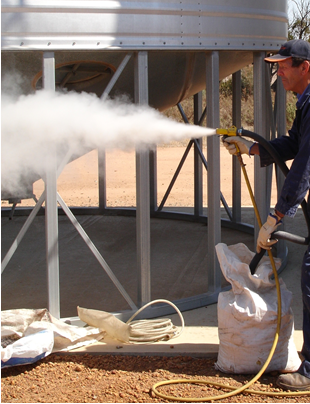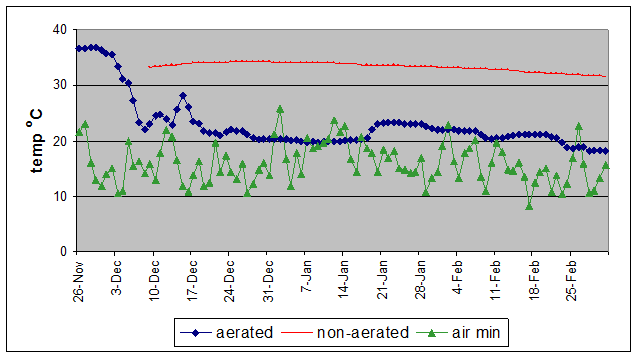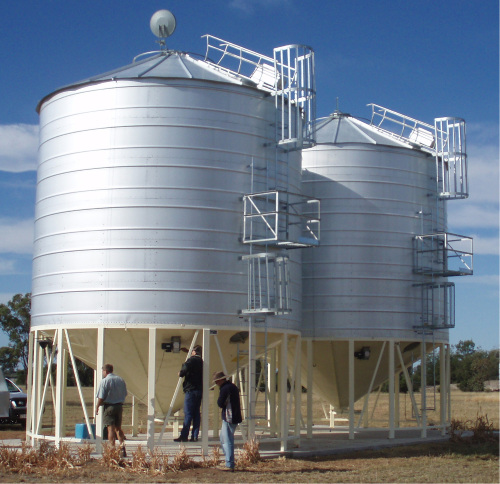Grain storage best practice A strategic mix to achieve valuable results
Grain storage best practice A strategic mix to achieve valuable results
Author: Philip Burrill, DAFF Qld | Date: 25 Jul 2014
Take home message
Integrating a strategic mix of good hygiene practices, regular monitoring of grain and aeration cooling is a firm foundation for achieving effective pest control and reliable grain quality outcomes.
Always use gas-tight sealable storages when fumigating.
For grain stored in non-sealable storages and where there is no impact on potential grain markets, treatment with a grain protectant insecticide provides valuable storage pest control.
Integrated strategy summary
Used together, the following components will provide an effective strategy for controlling pests and maintaining quality in your stored grain.
Hygiene
Regular clean up of grain residues in empty storages and grain handling equipment significantly reduces the number of breeding sites for insect pests. For storages and equipment, physically clean &/or water wash out grain residues and dust on a sunny day, then consider a diatomaceous earth (DE) structural treatment.
Aeration
Fit aeration fans to storages and use them to reduce grain temperature. Cooling grain either slows or stops the insects breeding life cycle. Rust red flour beetle stops breeding at 20°C. Lesser grain borer stops at 18°C. All insects stop breeding below 15°C. Grain temperatures of less than 23°C in summer and less than 15°C in winter are achievable targets. Aerate grain as soon as it is put into storage. For reliable results use a good quality automatic controller to run fans, as they select the best temperature and humidity air to use.
Monitoring grain
Never ‘store and forget’: Sample, sieve and check insect traps in your grain at least once per month. Indentify pests and keep monthly records, including any grain treatments or fumigations.
Storage choices
Many older silos were not designed to be sealed gas-tight for the purpose of fumigation. Fit these silos with aeration fans and do a good job with hygiene. When buying new silos, look for a quality design, easy to clean, sealable and fitted with aeration fans. Ask the silo manufacturer if it meets the Australian Standard (AS 2628) for sealable silos. (i.e. passes a pressure test). Aim to have at least two sealable, aerated silos on your farm. This allows you to achieve an effective fumigation of any infested grain. As a general rule, only leave a silo sealed up during the required fumigation period of 7 to 20 days.
Major Pests

Grain storage pests treatments for Cereal grains - June 2014
Warning – Always check product labels for registered uses
BEFORE applying grain treatments - check with your GRAIN BUYER or Bulk Handler (depot) for acceptability of treatments and read LABELS carefully
Treatments
|
Grain disinfestants Used on infested grain to control full life cycle (adults, eggs, larvae, pupae). |
Grain protectants Applied to grain - post harvest. Not registered for use on infested grain as poor adult insect control |
Structural treatment |
|
Phosphine e.g. Fumitoxin ® In gas tight / sealable storages |
Pirimiphos-methyl |
Diatomaceous earth – (DE) Amorphous silica eg Dryacide® Effective internal structural treatment for storages and equipment. Some restrictions if used on grain |
|
Sulfuryl fluoride e.g. Profume® In gas tight / sealable storages |
Fenitrothion |
|
|
Controlled atmosphere CO2 N2 In gas tight / sealable storages |
Chlorpyrifos-methyl |
|
|
Ethyl formate + CO2 In gas tight / sealable storages |
Methoprene |
|
|
Chlorpyrifos-methyl + S-methoprene e.g. Reldan pluS ® |
||
|
Deltamethrin + Piperonyl Butoxide e.g. K-Obiol® |
||
|
Spinosad + Chlorpyrifos-methyl + S-methoprene |
A new grain protectant
Grain protectants are applied to clean grain, typically at harvest time while auguring grain into storage. They are not disinfestants, so are not to be applied to infested grain. This results in poor adult insect control and also selects for resistant insects.
Conserve™ On-Farm (chlorpyrifos-methyl, S-methoprene, spinosad) - Dow AgroSciences
Conserve On-Farm grain protectant has been available for on-farm use since November 2013 under PER 14362 .
Spinosad, one of three active ingredients in Conserve On-Farm, will provide up to 9 months protection against the key pest, lesser grain borer (Rhyzopertha dominica).
The product is sold as a twin pack containing two parts; Part A, 5 L drum of chlorpyrifos-methyl (500 g/L) and S-methoprene (30 g/L) and a Part B which consists of two 1 L drums of spinosad (120 g/L). Part A targets all major stored grain insect pests other than the lesser grain borer and Part B exclusively targets Lesser Grain Borer, including resistant strains.
The stewardship program for Conserve On-Farm requires agents selling the product to be trained and accredited to manage an end user declaration (EUD) process at the point of sale. Growers provide their NGR card details, sign the EUD and agree to only treat grain that is stored on the property where it was grown.
Conserve On-Farm is registered for use on all cereal grains excluding malting barley, maize and rice, with a “single application” restriction to ensure Maximum Residue Limits are not exceeded. It cannot be used on oilseeds or pulses and is not registered as a structural treatment for storages or equipment.
Conserve On-Farm has a nil withholding period (WHP), but grain should not be moved for a minimum of 24 hours post treatment to allow time to bind to the grain. The EUD conditions of use require growers to declare all Conserve On-Farm treatments by using a Commodity Vendor Declaration (CVD). This ensures that future owners of treated grain can manage the spinosad residues, and avoids double application.
Cost of treatment: Conserve On-Farm twin pack box treats 250 tonnes of grain at a cost of $3.40 / tonne.
Suggested on-farm uses: Farm retained planting seed; Grain held in storages that are difficult to fumigate (eg. non-sealable silos, grain sheds, grain bunkers); Grain held for stockfeed in non sealable storage.
Always check with any potential grain buyers prior to treating grain as there are a number of export and domestic markets that do not accept treated grain.
Treatment method: Check spray equipment nozzles and calibrate to deliver 1 L of solution per tonne of grain. For safety reasons use water to calibrate spray gear. Only make up enough mixed solution that will be used within 48 hours.
It is important to ensure good spray coverage on grain, so direct the spray nozzle onto grain flow as it is augered up and into the storage. Tubeveyors can have problems with achieving adequate grain & spray mixing to achieve good coverage. Aust-Mech Australian Conveyor Systems Pty Ltd have developed a grain spray system for their tubeveyors that potentially overcomes some of the problems with spray coverage.
Resistance management strategy: After 2 consecutive years of using Conserve On-farm, rotate with one year of the Bayer product K-Obiol (deltamethrin + piperonyl butoxide). Check the label and with potential grain buyers prior to use.
For further information on use of Conserve On-farm refer to the two Dow AgroSciences publications: “Conserve On-Farm – Frequently Asked Questions” and “Conserve On-farm - Grain Protector Technical Reference and Users guide”.www.conserveonfarm.com.au
Structural hygiene treatment – storages & grain handling equipment
Diatomaceous earth – (DE) (Amorphous silica e.g. Dryacide®)
A high standard of “hygiene” for grain storage facilities and grain handling equipment is the foundation for successful pest management. Regular clean up of grain residues in empty storages and grain handling equipment significantly reduces the number of pest breeding sites. During most of the year, particularly in the warmer months, storage pests fly looking for fresh grain to infest.
An on-farm check of a header at the start of the wheat harvest on the Darling Downs found over 1000 lesser grain borers in the first 30 kg of wheat passing through the header. If the header had been cleaned down then treated with diatomaceous earth (DE) after the previous seasons sorghum harvest, this serious hygiene problem may have been avoided. Grain residues left inside empty silos pose a similar infestation risk. Warm sheltered locations with a bit of tucker are good breeding sites for storage pests. Physically cleaning out grain residues followed by a DE treatment provides the best hygiene results. DE is one of the few hygiene treatments that can be safely used as a silo structural treatment for cereal grains, pulses and oilseeds.
Diatomaceous earth (DE) is an inert dust made from the fossil remains of diatom skeletons. DE has proven insecticidal properties. Diatoms are a type of green or brown algae that grow in fresh-water lakes and marine estuaries. There are many thousands of species of diatoms and the amorphous silica skeleton of each species has a unique size and shape. DE produced from various mine sites in Australia and overseas have different properties and way the DE is processed after digging it up also affects its properties. It should be of no surprise than that, of the several commercial DE products available to growers in Australia, there is a significant difference in their efficacy against storage pests.
We tested the efficacy of four commercial DE products, plus lime – Dryacide®, Permaguard®, Cut’n’dry®, Absorbacide® and Aglime® in the laboratory in 2013. The most significant difference between them was their efficacy against rust red flour beetle (Tribolium castaneum) with only one product showing acceptable results. There is a repeat trial planned in late 2014 to confirm results.
Research done in the USA indicates that the killing action of DE is due to its ability to absorb the wax layer covering the insect’s body. This damage to the insect’s outer water-proofing layer leads to desiccation and eventual death of the insect over a number of days.
Therefore, DEs works most effectively in dry environments. Stored cereal grains, such as wheat, must be stored at no greater than 12% moisture content, or below 60% RH for DEs to be effective.
Application
While the Dryacide® label allows for its use as both a structural surface treatment and a grain treatment (1 kg / tonne), currently the main focus for DE use should be the structural treatment, in most circumstances.
Grain treatment
The problem for grain treatment at the label rate of 1 kg DE / tonne of grain, is that it affects grain flow characteristics and therefore handling and also has an impact on grain ‘angle of repose’. For this reason most bulk handling companies (e.g. Graincorp etc.) and other grain buyers do not accept bulk grain treated with DE. Presence of DE in grain can also impact on milling quality and there may also be other specific market objections to DE dust application to bulk grain. Always check before applying it to grain. Retail cost for DE ranges from $6 - $10 per kg., making it a relatively expensive treatment for grain.
Structural treatment – storages & grain handling equipment
DE can be applied to structures and equipment either dry or as a slurry in water. The rate for dry dust application (straight out of the bag) is 2 g/m², which is equivalent to 1 kg of DE over 500 m². A Blow-Vac gun is one option for application. See Figure 1. “Using a Blow-vac gun to apply DE”.

Figure 1. Using a blow-vac gun to apply DE
DE dust can also be mixed into water at 120 g dust / L water applied at a rate of 5 litres per 100 m² giving an application of approx. 6 g /m² dry basis to the storage structure.
The label specifies a flat fan nozzle with at least 5 litres/minute flow rating, so an XR11015VK ceramic nozzle would be a suitable choice. The ceramic will withstand the abrasion much longer than a plastic nozzle, at 3 bar this nozzle will give you 5.9 L/min.
So for all storages and equipment, physically clean &/or wash out with water all grain residues and dust, then consider using a DE structural treatment to deal with any remaining pests.
For further information on DE search on www.storedgrain.com.au
Aeration cooling – benefits and management
Well managed aeration cooling is very valuable, as it not only helps maintain grain quality, it also slows or stops the life cycle of most grain pests. Aeration cooling should be able to achieve temperatures below 23 degrees Celsius in summer and less than 15 degrees in winter in stored grain. See Figure 2 “Comparing aerated and non-aerated grain temperatures in storage”

Figure 2. Comparing aerated and non-aerated grain temperatures in storage
Aeration cooling fans should provide air flow rates of 2 to 4 litres of air per second per tonne. A fan operating on a silo holding 100 tonnes of wheat should provide around 300 litres of air per second for efficient aeration cooling of this grain.
The most reliable results are achieved when an automatic controller is used to turn fans on at the best times of the day or night. The “time proportioning” controllers run the fan for about 100 hours a month using the best available ambient air.
Manually operating fans has often resulted in fan left running at times of high humidity air, occurring during fog, mist and rain periods. This can lead to serious grain moisture problems in the silo. A good quality automatic controller constantly measures ambient temperature and humidity to ensure such problems are avoided.
For further information on Aeration Cooling or drying download the GRDC booklet “Aerating Stored Grain – cooling or drying for Quality Control. www.storedgrain.com.au or www.grdc.com.au
Contact details
Philip Burrill
Department of Agriculture, Fisheries and Forestry (DAFF Qld)
Ph: 0427 696 500
Fx: 07 4660 3600
Email: philip.burrill@daff.qld.gov.au
Reviewed by
Pat Collins
® Registered trademark

